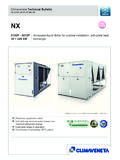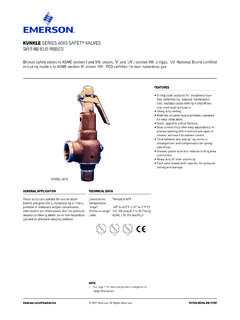Transcription of TECHNICAL BULLETIN 189 - A1 Gas
1 TECHNICAL BULLETIN 189. Date issued: 12th August 2008 Author: Jamie Cooper Status: Current Reviewer: August 2009. Title: Air/Gas Ratio Valves Note: This TECHNICAL BULLETIN updates TB 189 published 12th February 2007 which has now been withdrawn THIS TECHNICAL BULLETIN IS FOR INFORMATION PURPOSES ONLY AND IS NOT. INTENDED TO BE USED IN PLACE OF APPLIANCE MAUFACTURER'S INSTRUCTIONS. ALWAYS REFER TO APPLIANCE MANUFACTURER'S INSTRUCTIONS FOR SETTING AND. ADJUSTMENT REQUIREMENTS. Introduction Gas operatives will be familiar with the need to check gas valve settings by measuring the burner pressure with a manometer and comparing the result to the values supplied by the appliance manufacturer, either by reference to the appliance data badge or the installation instructions.
2 With many modern gas-fired condensing boilers, this procedure cannot be used because they use a different type of gas valve even though they may be similar in appearance. This TECHNICAL BULLETIN describes the air/gas ratio valves that are found on many condensing boilers and highlights the differences between these and standard' gas valves. Over recent years, legislation in the United Kingdom has been introduced that requires the use of high efficiency boilers both for new installations and for the majority of replacements in existing dwellings. In order to maximise the performance over the full boiler operating range, it is necessary to minimise the amount of excess air that passes through the boiler.
3 This has resulted in the greater use of gas valves that control the ratio of gas to air. The valve has proved especially useful in modulating appliances where direct control of the fan has enabled a simple control over the gas pressure and combustion over a wide range of modulation, typically :1. These valves are referred to by a number of different terms. Most frequently used are gas control valves , air/gas ratio valves or simply gas valves . This different terminology makes it difficult to identify which boilers may have this type of valve. Typically, a SEDBUK (Seasonal Efficiency of Domestic Boilers in the UK) band A' boiler will have these valves fitted but it must not be assumed that a boiler which is not a SEDBUK band A' rating will not have an air/gas ratio valve.
4 It must be emphasised that when working on appliances with this type of valve that the appliance manufacturer's instructions must always be referred to. It is imperative that gas operatives do not try and adjust air/gas ratio valves unless: the appliance manufacturer's instructions clearly indicate that they can be adjusted and the procedure to be followed;. they have the necessary equipment in order to carry out the adjustments to the manufacturer's instructions and where necessary that equipment is calibrated regularly;. TECHNICAL BULLETIN 189. Page 1 of 10.
5 CORGI has used its best efforts in the production of this information, but makes no warranty about the content and will not be held liable under any circumstances for any direct or indirect damages resulting from the use of this information. This document may not be reproduced in whole or in part without the consent of CORGI other than for personal reference purposes only. This document is uncontrolled when printed, please see for controlled (current) copy. they are competent to use that equipment and interpret any results obtained. Important: A number of appliance manufacturers will indicate that the air/gas ratio valves are not intended to be adjusted.
6 If this is the case then do not alter any of the valve settings. If adjustments are made to an air/gas ratio valve without following the specific manufacturer's instructions, it may result in the boiler combustion being adversely affected with the possibility of high levels of carbon monoxide (CO) being generated. Air/Gas Ratio Valves - operation The majority of air/gas ratio valves used on new appliances operate on a similar principle. However, it is important to note that some older appliances may have air/gas ratio valves using a different design. As in all modern boilers, a fan is used to provide the airflow to the burner.
7 The speed of the fan is accurately controlled by the electronic boiler control. This airflow generates a pressure drop across an air restrictor or venturi and this pressure is communicated to the gas control via a servo' regulator. Nearly all of the air/gas ratio valves used today are termed 1:1 valves' so that if the fan gives 5mbar of air pressure then the gas valve will deliver 5mbar of gas pressure. The gas is delivered through a controlled restriction, which typically has a relatively large diameter of up to 10mm. This controlled restriction may be an orifice, traditional injector, a brass fitting or even an open calibrated pipe.
8 Two methods are in use in current appliances to develop the driving pressure for the gas valve servo. For ease, these are usually referred to as either positive or negative systems (see Figures 1a and 1b). Figure 1: Air/gas ratio valve configurations TECHNICAL BULLETIN 189. Page 2 of 10. CORGI has used its best efforts in the production of this information, but makes no warranty about the content and will not be held liable under any circumstances for any direct or indirect damages resulting from the use of this information. This document may not be reproduced in whole or in part without the consent of CORGI other than for personal reference purposes only.
9 This document is uncontrolled when printed, please see for controlled (current) copy. In the positive system (Figure 1a), the gas valve and pressure tapping are downstream of the fan and are therefore under positive pressure. The gas is injected into or just after the venturi to aid mixing. In the negative system (Figure 1b), these components are upstream of the fan and under negative pressure; the gas may be injected directly into the fan. An air pressure tube may be used to connect the valve to the venturi (see Figure 2). If this tube becomes disconnected then, with either system, the air/gas ratio will be incorrect.
10 Alternatively, the gas valve may be positioned within a sealed compartment without a connecting tube on the servo connection; in this case it is important to note that the pressures may be affected when the cover door is removed to gain access to the valve. Figure 2: Air/gas ratio valve configuration use of pressure connecting tube TECHNICAL BULLETIN 189. Page 3 of 10. CORGI has used its best efforts in the production of this information, but makes no warranty about the content and will not be held liable under any circumstances for any direct or indirect damages resulting from the use of this information.







